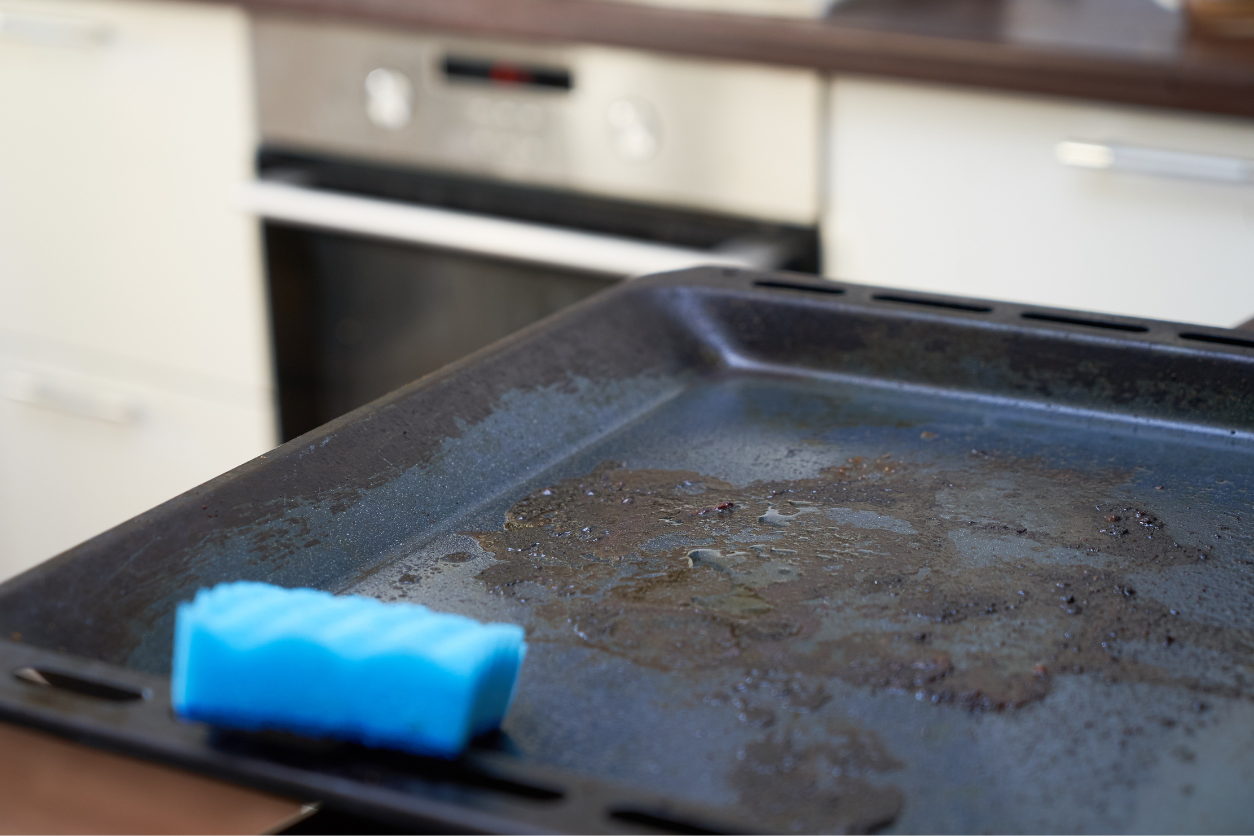Here’s How You Clean Those Burnt Baking Pans and Sheets

I love baking, but the one thing I can’t stand is the mess that comes with it. Cleaning up afterward, especially those baking pans covered in burnt-on food and stubborn grease, can feel like a never-ending battle. But before you think about tossing your pans, let me stop you right there—there’s hope! With the right approach, you can clean even the most stubborn pans without spending hours scrubbing or resorting to harsh chemicals. In this article, I’ll walk you through some easy, effective ways to get your baking pans and sheets looking like new. And you probably already have everything you need in your pantry.
Cleaning Baking Pans and Sheets
Let’s start by saying that there are different levels of ‘burned’ your pans and sheets can be. The method you’ll use depends on what you’re working with. For a little leftover grease or residue, a simple soap and water approach might do the trick. But if you’ve got a baking sheet or bread pan that looks like it’s survived a small kitchen fire, you’ll need something more heavy-duty. So, how do you tackle each situation?
For everyday cleanup, warm water and dish soap usually suffice. Fill your pan with warm, soapy water and let it soak for about 20-30 minutes. This softens up any grease or food remnants, making them easier to scrub away. Use a non-abrasive sponge to avoid scratching the surface of your baking pans and sheets. Simple enough, right? But what happens when that doesn’t work?
Try Scrubbing With Baking Soda
If your pans are still looking worse for wear after a quick soak, it’s time to level up your cleaning game. Baking soda is a versatile, non-toxic cleaner that works wonders on tougher messes. To use baking soda, sprinkle a generous amount directly onto the pan, focusing on the burnt areas. Then, add a little water to form a paste.
Let this baking soda paste sit for at least 15 minutes—longer if you’re dealing with particularly stubborn grime. The abrasive texture of the baking soda helps break down the baked-on food without damaging your baking pans and sheets. After letting it sit, clean with a sponge or a scrubbing pad. You’ll likely notice a significant difference already.
The Classic Vinegar-Baking Soda Combo
Now, if the baking soda paste alone didn’t quite cut it, or if you’re dealing with a layer of grease that seems welded to the pan, it’s time to bring out the big guns: the baking soda and vinegar combination. It’s an old-school cleaning hack for a reason—it works.
Here’s how you do it: pour a bit of vinegar onto your baking pans and sheets, then sprinkle a layer of baking soda on top. You’ll notice a fizzy reaction as the two ingredients interact, which helps loosen up the burnt bits. Allow the mixture to bubble and fizz for a few minutes before scrubbing with a sponge or brush. This method can cut through even the toughest grease and baked-on food.
Try Soaking Overnight
If your baking pans and sheets have been through multiple rounds of cooking without a proper deep clean, an overnight soak can do the trick.
Fill the pan with a mixture of hot water and a couple of tablespoons of dish soap. If you want an extra boost, add a bit of vinegar to the water. Let the pan sit overnight—this extended soaking time will soften the baked-on residue, making it much easier to scrub off in the morning. You’ll still need a sponge and a bit of elbow grease, but the effort will be greatly reduced compared to scrubbing a dry, burnt surface.
Scrub With Aluminum Foil
Aluminum foil can work as a great cleaning tool! For metal baking pans and sheets (not non-stick ones), A crumpled-up ball of aluminum foil is just abrasive enough to scrape off the grime without scratching the pan’s surface.
Cleaning Non-Stick Baking Pans and Sheets
Non-stick baking pans require a bit more care when cleaning. You don’t want to use anything too abrasive that might damage the coating but you still need to get rid of those burnt bits and grease. A baking soda paste works well here, but skip the aluminum foil and heavy scrubbing.
With a soft sponge or a nylon brush. Then, soak in warm, soapy water for a few hours just to get rid of any stubborn burns. Steel wool and harsh scrubbers will damage the non-stick coating of your pan. Avoid these unless you want your pans to lose their effectiveness over time.
Once you’ve gone through the effort of cleaning your baking pans and sheets, it’s only natural to want to keep them looking that way for as long as possible. One of the best ways to do this is to use parchment paper or aluminum foil when cooking. These liners create a barrier between your food and the pan, making cleanup a breeze.
If you prefer cooking directly on the pan, consider applying a light coating of cooking spray or oil before adding your food. This helps prevent food from sticking and reduces the likelihood of burnt-on residue.
Our Recipe for Trust: Why Choose Kitchen Institute
At the Kitchen Institute, we're dedicated to providing reliable and accurate information on cooking trends, tips, and product reviews. Our team of passionate food enthusiasts ensures that every piece of content is thoroughly researched and based on real-world experience. We pride ourselves on our comprehensive and unbiased product reviews, rigorous research processes, and commitment to staying current with the latest culinary innovations. Trust us to enhance your culinary journey with quality insights and practical advice.